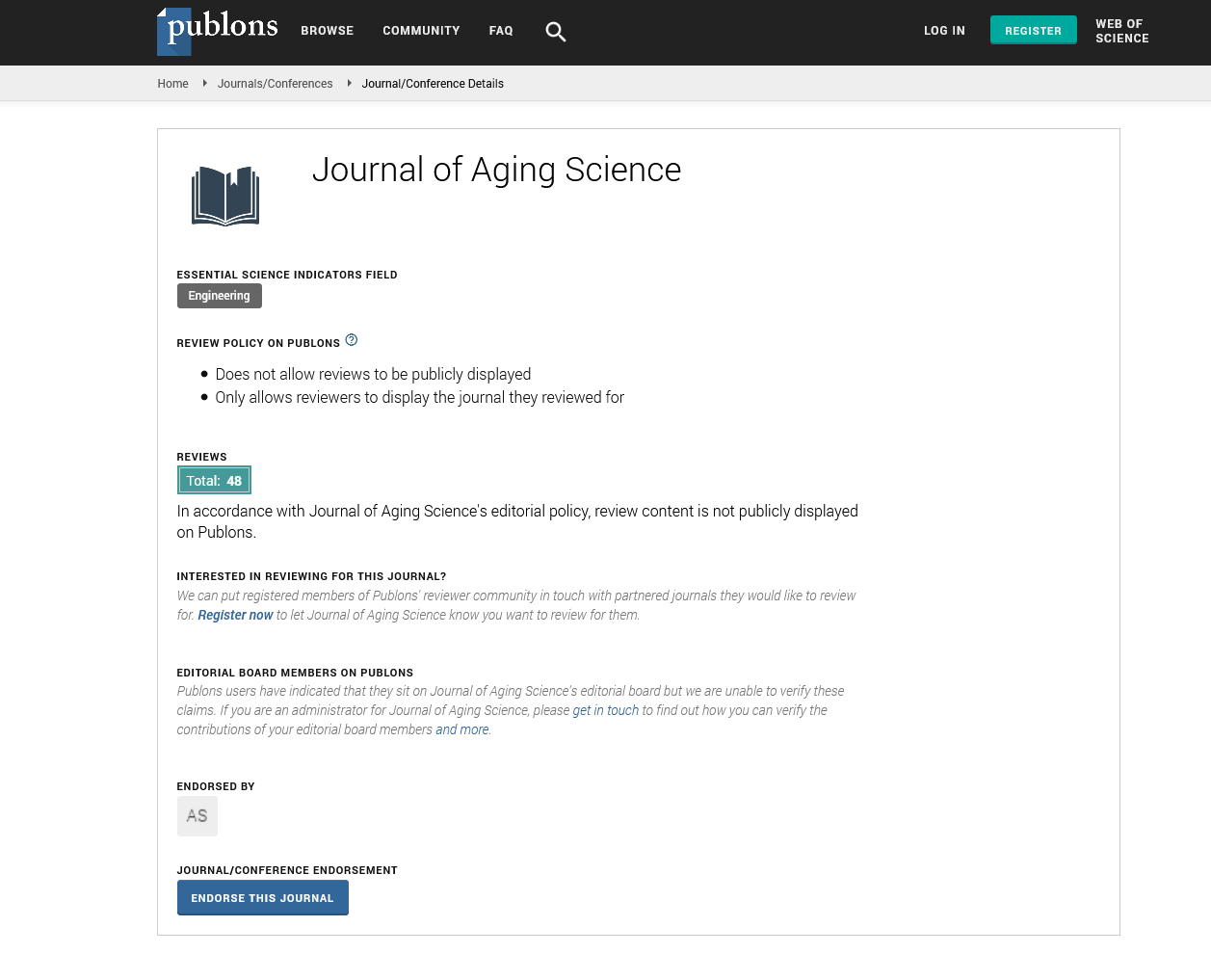Indexed In
- Open J Gate
- Academic Keys
- JournalTOCs
- ResearchBible
- RefSeek
- Hamdard University
- EBSCO A-Z
- OCLC- WorldCat
- Publons
- Geneva Foundation for Medical Education and Research
- Euro Pub
- Google Scholar
Useful Links
Share This Page
Journal Flyer

Open Access Journals
- Agri and Aquaculture
- Biochemistry
- Bioinformatics & Systems Biology
- Business & Management
- Chemistry
- Clinical Sciences
- Engineering
- Food & Nutrition
- General Science
- Genetics & Molecular Biology
- Immunology & Microbiology
- Medical Sciences
- Neuroscience & Psychology
- Nursing & Health Care
- Pharmaceutical Sciences
Short Communication - (2021) Volume 9, Issue 1
Neurotechnology for Bypassing Damaged Neural Pathways
Kenji Kato1* and Yukio Nishimura22Department of Dementia and Higher Brain Function, Tokyo Metropolitan Institute of Medical Science, Tokyo, Japan
Received: 06-Jan-2021 Published: 26-Jan-2021, DOI: 10.35248/2329-8847.21.9.246
Description
The functional loss of limb control in individuals with spinal cord injury or stroke is caused by interruption of corticospinal pathways, although the neural structures above and below the lesion retain their function. Bypassing the damaged pathway using brain-controlled Functional Electrical Stimulation (FES) to regain volitional control of a paralyzed limb is a promising approach for restoring lost motor function. Such an Artificial Neural Connection (ANC) can be produced by a computer interface that enables the detection of neural activity and converts it in real-time to activity-contingent electrical stimuli delivered to the nervous system.
An ANC that bridges the interrupted pathway and connects the cortex to a paralyzed limb could ameliorate the loss of function. An ANC works as an artificial neural pathway by creating a causal relationship between brain activity and evoked limb movements. Recently, we reported that monkeys with subcortical stroke could learn to use an Artificial Cortico-Muscular Connection (ACMC) that transformed cortical activity into electrical stimulation of the hand muscles, to regain volitional control of a paralyzed hand [1].
The ACMC was accomplished by chronically implanting electrocorticogram electrodes on the cortical areas over the Premotor Cortex (PM), primary Motor Cortex (M1), and primary somatosensory cortex (S1) in monkeys with limb paralysis caused by unilateral subcortical stroke. Then, one of the electrodes was selected arbitrarily and the frequency of one cycle-specific waveforms of high-gamma neural oscillations was assigned as the input signal for the ACMC. The output signal for the ACMC was sent to the paralyzed forelimb muscles, modulating stimulus intensity and frequency according to input signal frequency. The monkeys were required to volitionally modulate the activity of specific waveforms of high-gamma neural oscillations to generate muscle contractions in the paralyzed hand.
The monkeys were able to modulate the input signal of highgamma activity to control output electrical stimuli delivered to the paralyzed muscles via the ACMC. Thus, they could acquire targets by moving their paralyzed hand using the ACMC. Task performance improved over 20 min, suggesting that the monkeys could learn to use the ACMC with practice. The input electrodes for controlling the ACMC were switched randomly in each session among the PM, M1, and S1. Nevertheless, the monkeys could still improve task performance irrespective of the location of the input electrode. The demonstration of an ACMC from the M1 to a paretic forelimb muscle suggests that the ACMC replaced the function of the original descending motor neural pathway. The demonstration of an ACMC from the S1 to a paretic forelimb muscle implies that the S1, which normally has somatosensory functions, was given a new function, i.e., voluntary control of hand muscles. These results indicate that there is a certain flexibility in the ability to learn a novel ACMC even after subcortical stroke. This study may provide a useful option for restoring voluntary motor control in patients with stroke.
One of the challenges for the use of an ACMC is the muscle fatigue induced by the continuous use of electrical stimulation to the muscle. The majority of muscular force is produced by the activation of the fast muscle fiber type, which are also the most fatigable muscle fibers. However, in order to minimize the effect of muscle fatigue and maintain task performance, it is essential to adjust the stimulus parameters manually. Despite these challenges, [1] showed that task performance with muscle stimulation using an ACMC continued to improve for longer than 60 min. The force produced by the electrical stimulation was reduced to approximately half of the initial force after 30 min, indicating muscle fatigue. However, the monkeys could compensate for muscle fatigue by increasing the input gamma activity in the brain controlling the ACMC in order to maintain force output and task performance. Thus, the monkeys could achieve force control throughout an extended session with muscle fatigue. This is an advantage over previous implementations of FES in that it can remove the requirement for manual calibration.
Another challenge in the field of neuroprosthetics is the production of dexterous finger movements and functionally coordinated multi-joint movements. Of those people who survive a stroke, only 40–70% regain upper limb dexterity, e.g., the ability to reach, grasp, and manipulate objects [2]. The use of brain-controlled FES to muscles should be effective in such cases, and previous studies have shown the restoration of a series of functional goal-directed movements [3,4]. However, many electrodes for muscle stimulation were needed to induce functional movements. In contrast, our recent studies in monkeys demonstrated that spinal stimulation with a single electrode on the cervical cord evoked facilitative or suppressive responses in multiple muscles, including those located on proximal and distal joints, and activated synergistic muscle groups. For example, stimulation strongly facilitated finger extensor muscles, while they suppressed the antagonist muscles, which led to coordinated movements similar to natural voluntary movements [5,6]. Spinal stimulation may be a suitable target for restoring natural limb movements such as dexterous finger control and coordinated hand-arm movements.
Somatosensory feedback is essential for efficient and precise movements and to manipulate objects effectively. Spinal cord injury and stroke are common causes of somatosensory and motor impairment. However, no therapeutic strategy exists for impaired somatosensory function. Our prior work has shown that humans can respond to direct cortical stimulation of the S1, which engenders an artificial sensory percept organized according to standard somatotopy. Furthermore, we found a clear linear relationship between current intensity and the perceived intensity of the evoked sensation [7]. These results imply that the modulation of stimulation parameters, current intensity, and frequency can provide feedback for ongoing tactile information in real-time. In future studies, we will explore the possibility of closing the loop for a bidirectional sensory-motor neuroprosthesis by coupling stimulation-evoked somatosensory feedback in the S1 with real-time brain control of a paralyzed hand.
REFERENCES
- Kato K, Sawada M, Nishimura Y. Bypassing stroke-damaged neural pathways via a neural interface induces targeted cortical adaptation. Nat Commun. 2019;10(1): 4699.
- Houwink A, Nijland RH, Geurts AC, Kwakkel G. Functional recovery of the paretic upper limb after stroke: who regains hand capacity? Arch Phys Med Rehabil. 2013;94(5): 839-844.
- Ethier C, Oby ER, Bauman MJ, Miller LE. Restoration of grasp following paralysis through brain-controlled stimulation of muscles. Nature. 2012;485(7398): 368-371.
- Bouton CE, Shaikhouni A, Annetta NV, Bockbrader MA, Friedenberg DA, Nielson DM, et al. Restoring cortical control of functional movement in a human with quadriplegia. Nature. 2016;533(7602): 247-250.
- Nishimura Y, Perlmutter SI, Fetz EE. Restoration of upper limb movement via artificial corticospinal and musculospinal connections in a monkey with spinal cord injury. Front Neural Circuits. 2013;7: 57.
- Kato K, Nishihara Y, Nishimura Y. Stimulus outputs induced by subdural electrodes on the cervical spinal cord in monkeys. J Neural Eng. 2020;17(1): 01604 4.
- Kirin SC, Yanagisawa T, Oshino S, Edakawa K, Tanaka M, Kishima H, et al. Somatosensation Evoked by Cortical Surface Stimulation of the Human Primary Somatosensory Cortex. Front Neurosci. 2019;13: 1019.
Citation: Kato K, Nishimura Y (2021) Neurotechnology for Bypassing a Damaged Neural Pathway. J Aging Sci. 9: 246
Copyright: © 2021 Kato K, et al. This is an open-access article distributed under the terms of the Creative Commons Attribution License, whichpermits unrestricted use, distribution, and reproduction in any medium, provided the original author and source are credited

